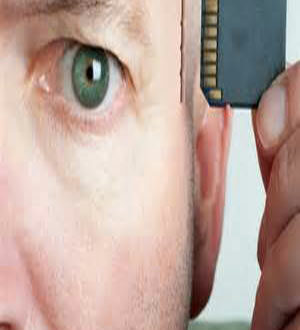From the USC press release:
USC: Restoring Memory, Repairing Damaged Brains
Biomedical engineers analyze—and duplicate—the neural mechanism of learning in rats
Scientists have developed a way to turn memories on and off—literally with the flip of a switch.
(Image Information)For stroke or Alzheimer’s victims, the promise of Dr. Theodore Berger’s recent breakthrough is enormous: imagine a prosthetic chip inserted in the brain that imitates the function of a brain’s damaged hippocampus (the region associated with long term memory). The current successful laboratory tests on rats, restoring long term memory at the flick of a switch, will next be duplicated in primates (monkeys) and eventually humans. (PRNewsFoto/USC Viterbi School of Engineering)
Using an electronic system that duplicates the neural signals associated with memory, they managed to replicate the brain function in rats associated with long-term learned behavior, even when the rats had been drugged to forget.
“Flip the switch on, and the rats remember. Flip it off, and the rats forget,” said Theodore Berger of the USC Viterbi School of Engineering’s Department of Biomedical Engineering.
Berger is the lead author of an article that will be published in the Journal of Neural Engineering. His team worked with scientists from Wake Forest University in the study, building on recent advances in our understanding of the brain area known as the hippocampus and its role in learning.
In the experiment, the researchers had rats learn a task, pressing one lever rather than another to receive a reward. Using embedded electrical probes, the experimental research team, led by Sam A. Deadwyler of the Wake Forest Department of Physiology and Pharmacology, recorded changes in the rat’s brain activity between the two major internal divisions of the hippocampus, known as subregions CA3 and CA1. During the learning process, the hippocampus converts short-term memory into long-term memory, the researchers prior work has shown.
“No hippocampus,” says Berger, “no long-term memory, but still short-term memory.” CA3 and CA1 interact to create long-term memory, prior research has shown.
In a dramatic demonstration, the experimenters blocked the normal neural interactions between the two areas using pharmacological agents. The previously trained rats then no longer displayed the long-term learned behavior.
“The rats still showed that they knew ‘when you press left first, then press right next time, and vice-versa,’” Berger said. “And they still knew in general to press levers for water, but they could only remember whether they had pressed left or right for 5-10 seconds.”
Using a model created by the prosthetics research team led by Berger, the teams then went further and developed an artificial hippocampal system that could duplicate the pattern of interaction between CA3-CA1 interactions.
Long-term memory capability returned to the pharmacologically blocked rats when the team activated the electronic device programmed to duplicate the memory-encoding function.
In addition, the researchers went on to show that if a prosthetic device and its associated electrodes were implanted in animals with a normal, functioning hippocampus, the device could actually strengthen the memory being generated internally in the brain and enhance the memory capability of normal rats.
“These integrated experimental modeling studies show for the first time that with sufficient information about the neural coding of memories, a neural prosthesis capable of real-time identification and manipulation of the encoding process can restore and even enhance cognitive mnemonic processes,” says the paper.
Next steps, according to Berger and Deadwyler, will be attempts to duplicate the rat results in primates (monkeys), with the aim of eventually creating prostheses that might help the human victims of Alzheimer’s disease, stroke or injury recover function.
The paper is entitled “A Cortical Neural Prosthesis for Restoring and Enhancing Memory.” Besides Deadwyler and Berger, the other authors are, from USC, BME Professor Vasilis Z. Marmarelis and Research Assistant Professor Dong Song, and from Wake Forest, Associate Professor Robert E. Hampson and Post-Doctoral Fellow Anushka Goonawardena.
Berger, who holds the David Packard Chair in Engineering, is the Director of the USC Center for Neural Engineering, Associate Director of the National Science Foundation Biomimetic MicroElectronic Systems Engineering Research Center, and a Fellow of the IEEE, the AAAS, and the AIMBE.
SOURCE USC Viterbi School of Engineering RELATED LINKS
http://www.viterbi.usc.edu
Following the link to the University website we find the following research centers and programs associated with the school.
Programs
»Aviation Safety and Security Program» Distance Education Network» Masters and Professional Programs» Globalization and International Programs
National Research Centers» Biomimetic MicroElectronic Systems» Center for Energy Nanoscience» Integrated Media Systems Center
» DHS Center for Risk and Economic Analysis of Terrorism Events
» The National Center for Metropolitan Transportation Research
» Listing of Viterbi School Research Centers and Labs
This technology has potential for a wide array of applications. It could even be the breakthrough needed to create the the first long-imagined artificial intelligence network.
However, given the association between the University and the Federal Government’s Department of Homeland Security, and related studies on terrorism, which is constantly being used as an excuse to chip away at the civil liberties and constitutional rights of US citizens, my bets are the Feds will use this in the war on terror before they try using it for good.
That means the potential for misuse to enact a true Orwellian-style “thought police” and even the ability to implement complete mind control among hosts.
Perhaps an even scarier thought is what becomes of this technology when it becomes wireless?
Alexander Higgins is a Senior NJ ASP.Net Developer. If you want the latest buzz, analysis, and news without the snooze, visit his comprehensive work at Alexander Higgins Blog
Related Articles:
From Liberal to Libertarian: Bush, Obama and the Final …
The U.S. Monetary System and Descent into Fascism
Does Our Brain Really Create Consciusness?
The Strange World of NSA Mind Control
 Mouood Mouood English Edition
Mouood Mouood English Edition




